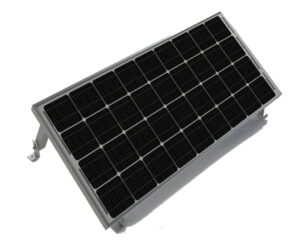 I received a question on Twitter today, so I made it into a blog post. Thanks Navigator! Her question referred to DIY Tilting of RV Solar panels, what types of mounts to use, and can you glue panels down. I’m in favor of tilting RV Solar panels, so let’s get her mounting questions answered.
I received a question on Twitter today, so I made it into a blog post. Thanks Navigator! Her question referred to DIY Tilting of RV Solar panels, what types of mounts to use, and can you glue panels down. I’m in favor of tilting RV Solar panels, so let’s get her mounting questions answered.
What’s your opinion on roof brackets. Tilting vs flat and I’ve seen some glued not screwed. Is that a thing?
Unfortunately, some people glue or even tape down (with very high bond tape) their solar panels. These are both terrible ideas. Never, ever do it! I’d also avoid flexible panels if possible. Many only last about a year, while glass monocrystalline or polycrystalline panels can last 20 or more years. I just bought another Newpowa 12-Volt 200W Monocrystalline Solar Panel yesterday on Amazon. FYI, I’ve found that many less expensive panels are about as good as the more expensive ones. I also have several HQST 12-Volt 100W Monocrystalline Solar Panels that I like very much. They are useful for small sections of your roof. In the future, I’ll have a blog post about mixing and matching different wattages and voltages of solar panels. Improperly matched solar panels will reduce your solar energy capture drastically.
I think roof brackets are the only way to go. They can be permanent or tilting. I’ve heard good things about Renogy’s Z Solar Panel Mounting Bracket, and they might even work on other solar panel brands. It’s important for air to get underneath the solar panel. It’s a bit counterintuitive, but a cooler solar panel is more efficient than a hot one, so you need airflow underneath it.
There are many solar mounting brackets on Amazon so make sure the ones you select will fit your panels. You will likely find some universal ones.
I don’t know what kind of roof you have, but Adventurous Way has a great section (Step 4) on mounting panels on a membrane over a plywood roof. This is exactly how I mount solar panels. Verify what type of roof and what type of sealant you should use with your RV manufacturer. I use Dicor 10.3 Oz Tube of 501LSW-1 Self-Leveling Lap Sealant liberally underneath the brackets and on top of the screw head and bracket.
I like tilted panels very much, but you should consider where you travel to, when you travel, how much solar you have, and how much energy storage you have. An excellent example of a mount for tilted solar panels is Renogy’s Adjustable Tilt Mount Brackets for 100W solar panels sold on Amazon.
If you are in wide-open spaces with no shade, such as the desert, tilting may not be required unless your batteries normally don’t get fully charged. If you only travel during the summer, there are more sunlight hours then, so tilting may not be necessary either. I always prefer having the option to tilt them, even if I have to do it manually. I’m not a big fan of a motorized system. Avoid the “Automatic” follow the sun motorized units. They don’t work.
A good rule of thumb is for every degree of latitude you are at, you should tilt your solar panels by the same amount. If you RV in the northern environs, tilting might be required, especially in the winter. FYI, I typically lay the solar panels on the roof without affixing them to see what level of charge I’m getting before affixing them; that way, I can determine if they need tilting. Only test them this way if your RV will be stationary and heavy winds aren’t expected. Tilting panels can greatly increase your energy capture in many circumstances. There are a lot of tilt mounting options on Amazon too. Here’s a great video about tilting solar panels. RV Solar Panel Tilting for Maximum Boondocking Power || Off-Grid RV Solar Power!
Navigator, that was a great question. Feel free to reach out to me on Twitter or via my Contact Me page or drop a comment below.
Thanks,
Carl

Thanks for the great tips and the links. Now we really have no excuse not to get this project finished. We really didn’t like having to run our generator while boondocking this year